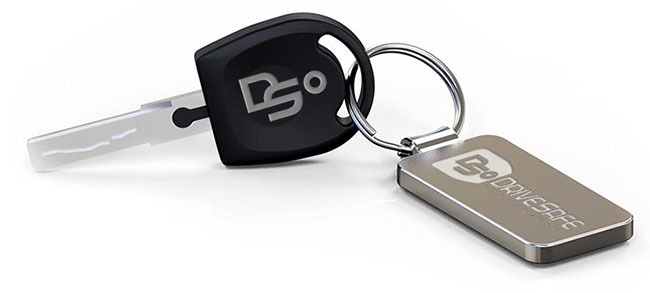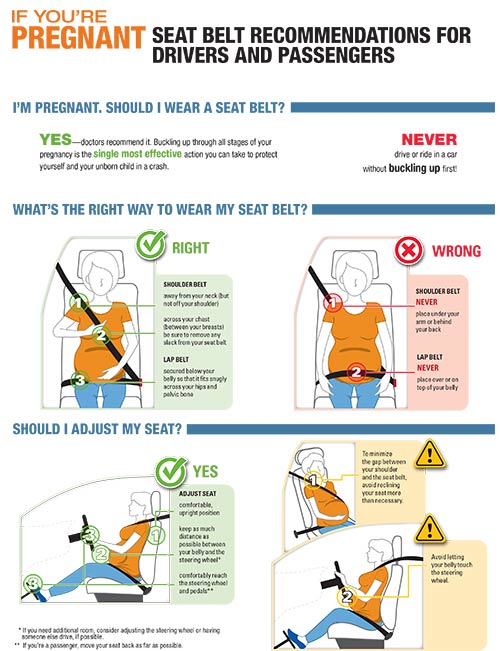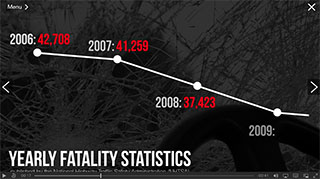Driving While Pregnant: Safe Driving Tips for Expectant Mothers
Pregnancy changes things.
From food to clothes to social activities and more, pregnant people often find themselves making changes to ensure the health and safety of the baby – or babies – that they’re carrying.
And driving is another area that may require some modifications. If you’re expecting, you may need to make some simple adjustments to keep yourself and your precious cargo safe when you’re behind the wheel.
Let’s take a look at some easy, common-sense strategies for safe driving during pregnancy.
Getting Behind the Wheel When Pregnant
As your belly grows, you will likely need to adjust the position of your vehicle’s seat. Leave as much space as possible between your stomach and the steering wheel but be sure that you can comfortably reach the pedals. You should also be close enough that you can turn the steering wheel fully without losing contact. If you’re able to adjust the angle of your steering wheel, tilt it upwards so that the wheel is angled towards your breastbone.

DRIVESAFE ONLINE DEFENSIVE DRIVING COURSES
Easy to Complete. Receive an Insurance Discount. Money-Back Guarantee!
Mobile-friendly viewing
Fully narrated video with closed captioning
Intelligent bookmarking to start/stop when you want
99% passing rate on user’s first attempt
Certificate emailed immediately after completion
Only $24.95
1-HOUR
6-HOUR
A vehicle with a three-point safety harness is your safest option for driving during pregnancy. A three-point harness has both a lap belt and a shoulder belt. Place the shoulder belt between your breasts and to the side of your belly. The shoulder belt should fall across the center of your shoulder and chest. Ensure that the shoulder belt does not rest against your neck. Never put the shoulder belt behind your back or under your arm.
The lap belt should be snug but not tight. Make sure that it crosses your hips under your stomach rather than resting on your belly. Keep it snug across your pelvis.
Be sure to remove all bulky outwear that could keep the safety harness from doing its job. And if your vehicle is equipped with airbags, be sure that they are engaged. In many cases, airbags are the difference between life and death in an accident.
Additional Precautions for Driving While Pregnant
The challenges of pregnancy and driving aren’t limited to the physical aspect of getting behind the wheel.
Pregnancy demands a lot of the pregnant person, and those demands can often result in distractions that could affect the ability to drive safely. For example, nausea is a common side effect of pregnancy. So are heartburn, anxiety, stress, and insomnia. Anyone who feels unwell, for any reason, could find themselves driving distracted. So, if you’re experiencing these types of effects during your pregnancy, it may be helpful to catch a ride with someone or take public transportation to avoid a distracted driving incident.
And while most of us might get hungry or thirsty on a long car ride, it’s not unusual for pregnant people to have increased food and hydration needs at all times of day or night. Plan ahead to have snacks and beverages on hand that you can pull over and safely consume as needed.
You should also be thinking about breaks not just for snacking, but also for stretching, walking, and using the restroom. If you’ll be in a vehicle – as a driver or passenger – for more than an hour, make sure that you have scheduled stops into your itinerary.
Pregnant people are especially susceptible to deep vein thrombosis (DVT), a potentially fatal blood clot that can occur when limbs are immobile for an extended period of time. Stretching and walking are the best ways to avoid these issues. You can also use these breaks to fuel up, hydrate, and go to the bathroom to ensure that you aren’t distracted by these needs when you get back behind the wheel.
Know Your Driving Limits When Pregnant
The human body’s ability to grow a baby is a wonderful thing. But that doesn’t mean there aren’t limits to what you can do. Recognizing and respecting your boundaries is the most important element to safe driving during pregnancy.
You may reach a point in your pregnancy where driving is no longer comfortable. And if you’re thinking about the discomfort, your focus is not on the road. If back pain, joint pain, or other effects of pregnancy are impacting you, it may be best to avoid driving. Use ridesharing or ask friends and family to chauffeur you as needed.
Likewise, if you reach a point where you’re physically unable to wear your seat belt, reach the pedals without your stomach resting on the steering wheel, or can’t look over your shoulder into your blind spot, it’s time to take a break from driving. Your safety and the safety of your child is of far greater importance than any errand you might need to run.
How Can Defensive Driving Help Pregnant Mothers?
In addition to following these guidelines for safe driving during pregnancy, there’s something else you can do to protect yourself and your baby – consider taking a defensive driving course to help you refresh your skills.
DriveSafe Online offers cutting edge defensive driving courses that use drone footage and a cinematic approach to help you visualize risky situations – and learn how to handle them before they happen to you. We’ll help you prepare for a variety of situations you may encounter, because a prepared driver is a safer driver.
Plus, you could earn a defensive driving discount from your insurance provider by taking our course. With a growing family, we know that every penny counts, and we’d love to see more of your hard-earned money stay in your pocket. Contact your agent to learn about your eligibility for savings.
With 25 years of experience creating online learning courses, you can rest assured that you’re getting the best. In fact, we were named “Best Overall Online Defensive Driving Course for 2021” by Investopedia. If you still have questions about whether DriveSafe Online is right for you, contact our customer support team or take a course demo to see for yourself.

Patrick M. is Editorial Director for the always expanding DriveSafe Online library of courses. With over two decades of experience developing award-winning training, he now focuses on innovating online driver safety training. Pulling from his background in journalism, he steers the wheel behind the creation of top-tier content that promotes a better journey—whether on the digital highway of learning or the real roads we travel every day.


